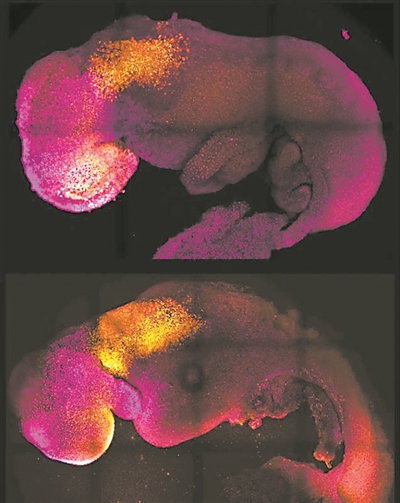

The Webb Space Telescope's 6.5-meter primary mirror can detect objects billions of light-years away. Image source: "Nature" magazine website

Researchers can create synthetic embryos that resemble natural embryos in the lab. Image source: "Nature" magazine website
From single-molecule protein sequencing to bulk electron microscopy, in a recent report on the website of the British "Nature" magazine, it listed seven technologies that are likely to improve scientific research methods in 2023.
The dawn of single-molecule sequencing
Single-molecule technologies that can sequence many proteins in a sample may be on the horizon.
The University of Texas is working on a "fluorescence sequencing" method, and the US biotechnology company Quantum Silicon has described technology that uses fluorescently labeled "adhesives" to identify specific amino acid sequences at the ends of proteins.
Other researchers are developing single-molecule sequencing techniques that mimic nanopore-based DNA sequencing, which can analyze amino acids based on changes in electrical current caused by peptides passing through tiny channels. A team at the Technion-Israel Institute of Technology is working on solid-state nanoporous devices made of silicon-based materials that can simultaneously perform high-throughput analysis of multiple protein molecules.
Webb Telescope Continues
The James Webb Space Telescope is the most powerful space telescope ever built, designed specifically to detect infrared radiation, allowing it to see back to the time when the first stars and galaxies were forming in the universe. It can also measure certain types of extrasolar The composition of the planet's atmosphere.
Researchers around the world are eagerly awaiting the latest observations from the Webb Telescope, which Cardiff University in the UK is using to study how the cosmic dust that can lead to the formation of stars and planets is produced.
Stereo Electron Microscopy Takes It to the Next Level
Researchers are using electron microscopy to study 3D tissue samples covering several cubic millimeters.
The newly emerging "bulk electron microscope" technology has its own advantages and disadvantages: the continuous block imaging technology can process samples close to 1 cubic millimeter in size, and the speed is relatively fast, but the depth resolution is poor; the focused ion beam scanning electron microscope (FIB -SEM) technique has higher depth resolution, but is more suitable for smaller samples. A team of scientists used an advanced custom-made FIB-SEM microscope to increase the imageable volume in a single experiment by 200-fold while maintaining good spatial resolution, revealing a variety of cellular and subcellular structures within the complete 3D volume of many cells.
CRISPR technology blooms everywhere
The genome editing tool CRISPR-Cas9 has made major breakthroughs in the fields of gene therapy and disease modeling, but its application range is still limited, and scientists are trying to break through its limitations.
Using protein engineering techniques, Massachusetts General Hospital has produced a variant of the commonly used Cas9 enzyme from the bacterium Streptococcus pyogenes. 10%.
There are still many naturally occurring Cas variants yet to be discovered. The University of Trento in Italy combed more than 1 million microbial genomes to identify and characterize multiple distinct Cas9 variants that likely target more than 98% of known disease-causing mutations in humans.
Radiocarbon dating excellence
For archaeologists, radiocarbon has been a godsend. Scientists have used radiocarbon dating since the 1940s to narrow down the dates of historical events, but usually with an accuracy of decades.
In 2012, a Nagoya University team in Japan found a spike in the radiocarbon content of tree rings beginning in AD 774, and scientists have since found more such events. This sparked a revolution in archaeology. Finding such short spikes in ancient samples allows them to be dated to within a year, rather than the decades or even centuries of uncertainty associated with ordinary radiocarbon dating.
Archaeologists are using this method to date the formation of Neolithic settlements and volcanic eruptions, and within the next 10 years, many events in these ancient civilizations will be dated to precise dates.
Single-cell metabolomics is in the ascendant
Metabolomics drives the study of lipids, carbohydrates, and other small molecules in cells, initially as a means of characterizing metabolites in populations of cells or tissues, and is now moving to the single-cell scale. Scientists can use these cellular-level data to reveal the complex functions of large numbers of seemingly identical cells, but the transformation is challenging.
In 2021, the researchers launched SpaceM, an open-source software tool. Using light microscopy imaging data and spatial metabolomics analysis of cultured cells with the aid of standard commercial mass spectrometers, the researchers profiled hundreds of metabolites in tens of thousands of human and mouse cells, equivalent to standard single-cell transcription Omics approaches categorize these cells.
In vitro embryo models go a step further
Scientists have mapped in detail the development of mice and humans from a fertilized egg to a fully formed embryo at the cellular scale, but the molecular mechanisms that drive the early stages of this process remain unclear, and the "embryo-like" model helps fill in this knowledge gaps, allowing researchers to more clearly reveal important early events that can determine the success or failure of fetal development.
In 2022, a research team at the University of Cambridge in the UK used embryonic stem cells to create mouse embryos. Another group took a different tack: reprogramming human stem cells to mimic the earliest stages of human development. While not yet fully accomplished, it does return these stem cells to a state similar to that of an eight-cell human embryo. This is a crucial milestone.
(Original title "The dawn of single-molecule protein sequencing dawns. CRISPR technology is blooming everywhere "Nature": Seven technologies that are expected to improve scientific research in 2023")


